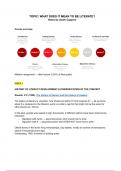TOPIC: WHAT DOES IT MEAN TO BE LITERATE?
Notes by Asiah Capponi
Course overview
Midterm assignment → after lecture 3 (20% of final grade)
WEEK 1
HISTORY OF LITERACY DEVELOPMENT & DIVERSIFICATION OF THE CONCEPT
Kaestle, C.F. (1985). The history of literacy and the history of readers
The history of literacy is uncertain, how should we define it? And measure it? → all we know
about it is centered on the Western world, so what is real for that might not be the same for
other places (ex. China)
In the past, people were asked to sign documents, 2 different options have been observed by
historians:
- Signature with name → assumed person who knows how to write
- Signature with X → assumed person who DOES NOT know how to write
Oldest library in the world: King Ashurbanipal, clay tablets, mostly an archive of transactions
(about 5 thousands years ago)
Guthenberg, 1450: invention of printing press
,Literacy is connected to power: wealthy people that could afford education were literaries (elites:
religious, accounting, record keeping, political administration)
Technological features of writing:
● Replication, transportation and preservation of messages → why we have stories of the
origins of different populations etc.
● Back-and-forth scanning
● The study of sequence: writing happens in a linear way
● Deliberation about word choice: you think about how to say things, different then when
you talk, which gives you less time to think
● The constructions of lists, tables, recipes and indexes
● Separation of message from author
From the 16th century on: Who promoted literacy the most?
- Printing press
- Renaissance
- Reformation
- Enlightenment: emancipation of public from the elites → democratization of literacy and
education
20th century: education is becoming a public good, accessible to all citizens
1920→ new mass media appear: radio, TV
Sound and visuals:
- CDs
- Recorders
- Cameras
Computers, Internet start entering houses
Diversification of the literacy concept: information, media, digital literacy → you should be
able to interpret and understand what you see and hear, rather than only read and talk, in order
to be literate
Are any particular new competences needed to navigate all of these new media?
Different types of literacy:
Reading literacy VS New literacy (digital literacy, information literacy)
How is the brain processing these new information? Are there any new brain parts who are
involved?
What are the possible social consequences of developing so many literacies?
Do people that are digital literates have a better chance to be successful in today’s society?
, Literacy= the ability to decode and comprehend written language at a rudimentary level, that is,
the ability to look at written words corresponding to ordinary oral discourse, to say them, and to
understand them.
Shift to written culture:
- Invention of writing
- Acquisition of writing from abroad
Invention of writing is a long, slow process
Mnemonic symbols evolved into word-syllabic systems among the Sumerians, the Aztecs and
Mayans.
From Egyptian writing evolved various syllabic systems and ultimately the alphabetic writing of
the Greeks.
Rayner, K. et al. (2001). How psychological science informs the teaching of reading
The general relationship among writing systems, orthographies, and languages. A given
language contains multiple units in both its basic phonological structure and its morphological
structure.
Logographic= systems whose units correspond to specific words (ex. Chinese)
Alphabetic principle= association of letters with phonemes
Difficulties:
● The abstract nature of phonemes
● Many alphabets do not code each vowel with a unique symbol
Reading= getting meaning from print
It’s different from literacy, which includes a variety of educational outcomes that go beyond
reading → BUT reading skill is the starting point for literacy





